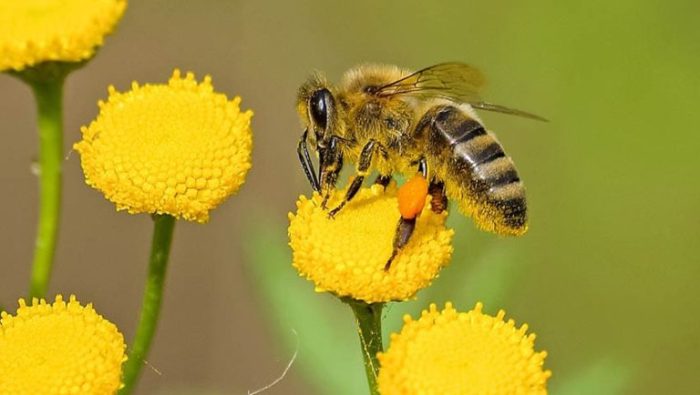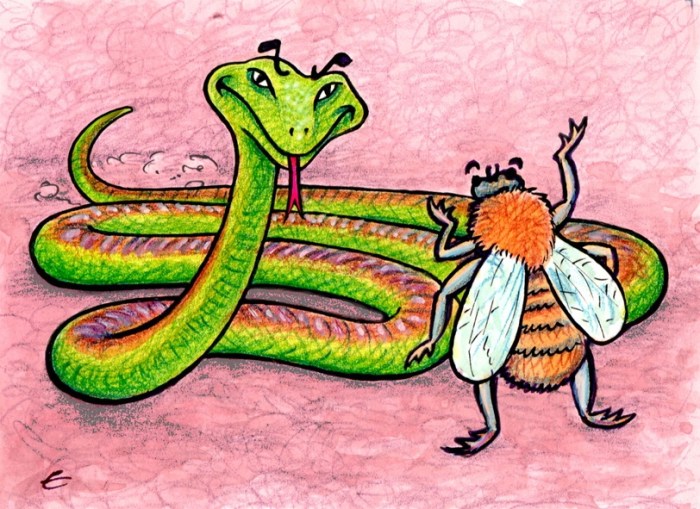Prepare to dive into the enchanting world of “La Abeja Haragana in English,” a timeless fable that has captivated readers across cultures for centuries. Join us as we explore the captivating story, its profound moral lessons, and its enduring impact on our modern lives.
This beloved fable introduces us to a cast of unforgettable characters and a narrative that weaves together themes of laziness, hard work, and the consequences of our actions.
The Lazy Bee

The fable of “The Lazy Bee” is a timeless tale that teaches the importance of hard work and responsibility. Found in various cultures worldwide, it serves as a cautionary tale against idleness and procrastination.
The story revolves around two main characters: a hardworking bee and a lazy bee. The hardworking bee diligently collects nectar and pollen to prepare for the winter, while the lazy bee spends its days lounging and enjoying the fruits of the hardworking bee’s labor.
Moral Lessons
The fable conveys several important moral lessons:
- The value of hard work:The hardworking bee’s diligence ensures its survival and well-being, while the lazy bee’s idleness leads to its downfall.
- The consequences of laziness:The lazy bee’s unwillingness to work results in it facing starvation and hardship when winter arrives.
- The importance of self-reliance:The hardworking bee’s ability to provide for itself through its own efforts is a lesson in self-sufficiency.
- The dangers of envy and resentment:The lazy bee’s envy of the hardworking bee’s success leads to its downfall.
Literary Analysis
The fable “The Lazy Bee” employs various literary devices to convey its message. Personification is used to attribute human characteristics to animals, such as the bee and the ant. The bee is portrayed as lazy and carefree, while the ant is depicted as industrious and hardworking.
This technique helps create a relatable and engaging narrative that highlights the contrast between the two characters.
Symbolism, La abeja haragana in english
Symbolism is another literary device used in the fable. The bee represents laziness and procrastination, while the ant symbolizes hard work and diligence. The honey represents the rewards of hard work, while the cold winter represents the consequences of idleness.
These symbols add depth and meaning to the fable, allowing readers to draw parallels between the characters and their own actions.
Imagery
Imagery is also used effectively in the fable. The vivid descriptions of the bee’s carefree life and the ant’s diligent labor create a strong sensory experience for the reader. The contrast between the bee’s bright colors and the ant’s dark, industrious appearance further emphasizes their contrasting personalities.
This imagery helps readers visualize the events of the fable and connect with the characters on a deeper level.
Structure
The fable follows a traditional structure, beginning with an introduction that establishes the setting and characters. The rising action introduces the conflict between the bee and the ant, followed by the climax, where the bee realizes the consequences of his laziness.
The falling action depicts the bee’s attempts to rectify his behavior, and the resolution provides a moral lesson about the importance of hard work.
Interpretations and Perspectives
“The Lazy Bee” is a timeless fable that has been interpreted in various ways. Some readers view it as a simple moral tale about the importance of hard work, while others see it as a commentary on social inequality and the dangers of laziness.
The fable can also be interpreted as a metaphor for the human condition, highlighting the struggle between our desire for comfort and our need for purpose.
Cultural Impact

The fable of The Lazy Bee has had a profound impact on art, literature, and popular culture across the globe. It has been adapted and reimagined in countless ways, reflecting the fable’s enduring relevance and cultural significance.
Adaptations and Variations
Over the centuries, The Lazy Bee has been adapted into various forms, including:
-
-*Literature
The fable has been retold in countless children’s books, short stories, and novels. Each adaptation often adds unique elements or perspectives, reflecting the cultural context of the time and region.
-*Art
The fable has inspired numerous works of art, including paintings, sculptures, and mosaics. These artistic interpretations often depict the lazy bee as a humorous or satirical figure, highlighting the consequences of laziness and the importance of hard work.
-*Popular Culture
The lazy bee, known as “la abeja haragana” in Spanish, is a tale that teaches us the importance of hard work. In the same vein, cloze ing in on science is an innovative approach to learning that encourages students to actively engage with scientific concepts, fostering a deeper understanding and appreciation for the subject.
Just as the industrious bees contribute to the hive’s success, students who embrace this approach will reap the rewards of enhanced scientific literacy.
The fable’s characters and themes have been referenced in popular culture, including movies, TV shows, and music. For example, the animated film “Bee Movie” (2007) features a lazy bee who learns the value of responsibility and teamwork.
Modern Applications: La Abeja Haragana In English

The timeless lessons of “The Lazy Bee” fable continue to resonate in modern society, offering valuable insights for personal development, work ethic, and social interactions. The fable teaches the importance of hard work, responsibility, and the consequences of laziness. By examining the characters and their actions, we can draw parallels to modern-day archetypes and apply the fable’s teachings to various aspects of our lives.
Character Comparisons
The characters in “The Lazy Bee” can be compared to modern-day archetypes, representing common personality traits and behaviors. For instance, the lazy bee can be likened to the “slacker” archetype, an individual who avoids work and responsibilities. In contrast, the hardworking ant represents the “achiever” archetype, who is diligent and goal-oriented.
| Fable Character | Modern-Day Archetype | Characteristics |
|---|---|---|
| Lazy Bee | Slacker | Avoids work, irresponsible, seeks easy solutions |
| Hardworking Ant | Achiever | Diligent, goal-oriented, responsible |
Visual Representation

The fable of “The Lazy Bee” has been vividly portrayed through various visual representations, ranging from traditional illustrations to modern adaptations. These visual depictions capture the key scenes and characters, enhancing the fable’s impact and appeal.
The fable’s setting is often depicted as a lush meadow or garden, with vibrant flowers and buzzing insects. The lazy bee is typically characterized as a plump and indolent creature, while the industrious ants are portrayed as small, hard-working individuals.
Other visual elements include the beehive, the ants’ nest, and the symbolic contrast between the bee’s idleness and the ants’ diligence.
Illustrations
Numerous illustrators have created their interpretations of the fable, each bringing their unique artistic style to the story. Some notable illustrations include:
- Aesop’s Fables by Arthur Rackham (1912):Rackham’s whimsical and detailed illustrations depict the lazy bee as a corpulent creature, while the ants are portrayed as tiny and diligent.
- The Lazy Bee by Beatrix Potter (1905):Potter’s charming illustrations feature a plump and lazy bee resting on a flower, while the ants scurry about their work.
- The Ant and the Grasshopper by Jean de La Fontaine (1668):La Fontaine’s illustrations depict a lazy grasshopper being scolded by a diligent ant, emphasizing the consequences of idleness.
Art Forms
Beyond illustrations, the fable of “The Lazy Bee” has also been interpreted in other art forms:
- Animation:The fable has been adapted into animated films, such as “The Grasshopper and the Ants” (1934) by Walt Disney Productions.
- Theatre:The fable has been adapted into stage plays, such as “The Ant and the Grasshopper” by Thornton Wilder (1955).
- Music:The fable has inspired musical compositions, such as “The Grasshopper and the Ant” by Jean-Philippe Rameau (1727).
Questions Often Asked
What is the main message of “La Abeja Haragana in English”?
The fable teaches the importance of hard work, responsibility, and the consequences of laziness.
How has “La Abeja Haragana” influenced popular culture?
The fable has inspired countless adaptations, including movies, plays, and children’s books.